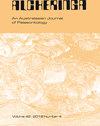一种新的“开裂”的dasyurid(有袋目动物),来自昆士兰州西北部的里弗斯利中新世
IF 1.5
4区 地球科学
Q3 PALEONTOLOGY
引用次数: 21
摘要
Ganbulanyi djadjinguli gen. et sp. 11是在昆士兰西北部Riversleigh早-晚中新世遗址的上磨牙和前磨牙的基础上描述的。材料的缺乏限制了确定其系统发育位置的确定性。但是,在dasyromorphians中,依赖于牙齿同源性的解释,该物种仅与衍生的dasyuria Sarcophilus和/或Barinya wangala显示出明确的近亲关系,Barinya wangala可能是现代Dasyurinae的姊妹分类单元(即,Sminthopsinae, Phascogalinae, Dasyurinae)。在G. djadjinguli中很明显的其他类形在该目的肉食性袋狼和袋狼中都是常见的。Ganbulanyi djadjinguli的一些牙齿特征被认为是对“骨裂”习惯的适应。如果这个解释是正确的,那么这个物种代表了唯一一个已知占据这样一个生态位的前上新世澳大利亚分类群,也许是哺乳动物中最小的专业“骨头客”。本文章由计算机程序翻译,如有差异,请以英文原文为准。
A new ‘bone-cracking’ dasyurid (marsupialia), from the Miocene of Riversleigh, northwestern Queensland
Ganbulanyi djadjinguli gen. et sp. nov. is described on the basis of an upper molar and premolar from an early-late Miocene site in Riversleigh, northwestern Queensland. The paucity of material constrains certainty in the determination of it's phylogenetic position. But, among dasyuromorphians, and dependent on the interpretation of tooth homology, this species shows unequivocal synapomorphies only with the derived dasyurine Sarcophilus, and/or Barinya wangala, a possible sister taxon to the modern dasyurid radiation (i.e., Sminthopsinae, Phascogalinae, Dasyurinae). Other apomorphies, evident in G. djadjinguli, are common to both carnivorous thylacinids and dasyurids within the order. Some dental features of Ganbulanyi djadjinguli are treated as adaptations to a ‘bone cracking’ habitus. If this interpretation is correct, then this species represents the only pre-Pliocene Australian taxon known to occupy such a niche and perhaps the smallest specialist ‘bone-cracker’ within Mammalia.
求助全文
通过发布文献求助,成功后即可免费获取论文全文。
去求助
来源期刊

Alcheringa
地学-古生物学
CiteScore
2.60
自引率
7.70%
发文量
28
审稿时长
>12 weeks
期刊介绍:
Alcheringa : An Australasian Journal of Palaeontology is the official journal of the Australasian Palaeontologists.
Alcheringa covers all aspects of palaeontology and its ramifications into the earth and biological sciences, including:
Taxonomy-
Biostratigraphy-
Micropalaeontology-
Vertebrate palaeontology-
Palaeobotany-
Palynology-
Palaeobiology-
Palaeoanatomy-
Palaeoecology-
Biostratinomy-
Biogeography-
Chronobiology-
Biogeochemistry-
Palichnology.
Review articles are welcome, and may be solicited from time to time. Thematic issues are also possible. Emphasis is placed on high quality and informative illustration, in both line drawings and photographs. Papers of general significance may receive preference over those of more local interest.
 求助内容:
求助内容: 应助结果提醒方式:
应助结果提醒方式:


